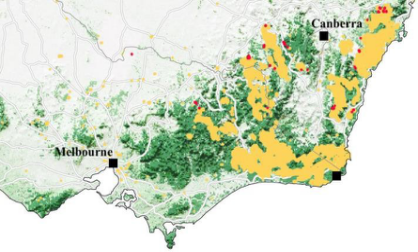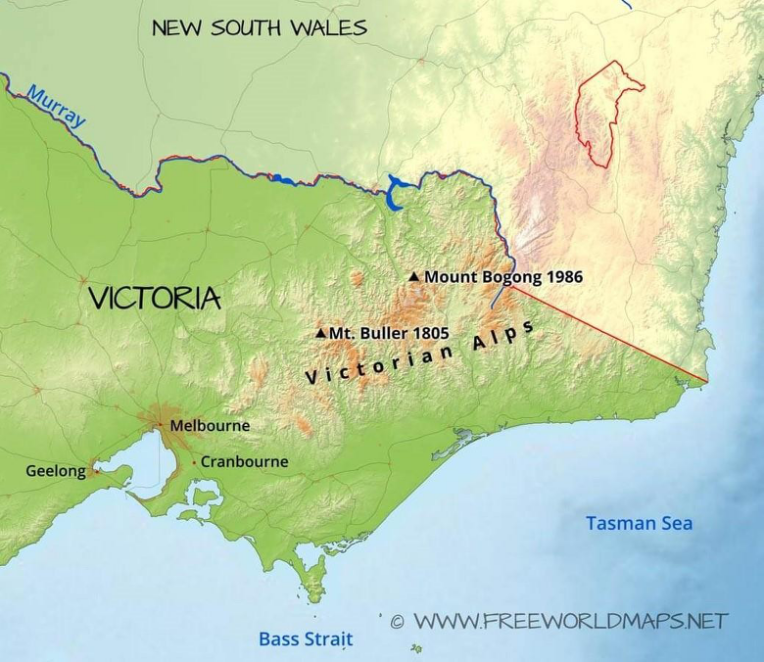2021 MCM B: Fighting Wildfires
The 2019-2020 fire season in Australia saw devastating wildfires in every state, with the worst impact in New South Wales and eastern Victoria. The wildfires occurred during a severe drought and persistent heat wave exacerbated by climate-change. Figure 1 shows the wildfire hot spots in this area from October 1, 2019 to January 7, 2020, with yellow showing fires from October 1st to January 6th, and red showing active fires on January 7, 2020.
Firefighters have used drones for surveillance and situational awareness (SSA) for several years; SSA drones carry high definition & thermal imaging cameras and telemetry sensors that monitor and report data from wearable devices on front-line personnel.
Wearable devices can be used as Personal Locator Beacons or more complex environmental monitors. SSA drones help monitor the evolving situation, letting the Emergency Operations Center (EOC) best direct active crews for optimal effect and maximal safety.
Figure 1. Wildfire Hot Spots in Southeast Australia, Oct 1, 2019 to Jan 7, 2020. Source: Australian Government Bureau of Meteorology, NASA Fire Information for Resource Management System.
Two-way radio communication allows “boots-on-the-ground” forward teams to give status reports to the EOC and allows the EOC to give orders directly to forward teams. Deployed personnel carry handheld two-way radios operating in the VHF/UHF bands. The range of handheld radios is limited by their low transmitting power, typically a maximum of 5 watts, and is determined mainly by distance and physical topography in rural areas or “building
topography” in urban areas; weather has little effect on VHF/UHF signals. A 5-watt radio has a nominal range of 5 km over flat, unobstructed ground, but drops to 2 km in an urban area.
Repeaters, transceivers that automatically rebroadcast signals at higher powers, can extend radio range. A repeater located between the front lines and the EOC can relay radio signals both from the front lines to the EOC and from the EOC to the front lines. The range of a repeater is also determined by distance and topography, but is significantly greater than lower power handheld radios.
Recently, hovering drones carrying repeaters have been used to dramatically extend the range of low power radios on the front lines. A 10-watt repeater, weighing 1.3 kg carried by a drone hovering well above ground level, can achieve a range of 20 km. Akme Corporation's prototype WileE–15.2X hybrid drone is projected to cost approximately $10,000 (AUD) when equipped with either a radio repeater or video & telemetry capability. Tests have shown this drone has the capabilities listed in Table 1.
Table 1. WileE–15.2X Hybrid Drone Capabilities
|
Flight range: 30 km |
Maximum speed: 20 m/s |
Maximum flight time: 2.50 hr |
|
1.75 hour recharge time for the built-in battery. Note: Auxiliary batteries for radios or video/telemetry can be swapped while the built-in battery recharges. |
||
Requirements: Your team of consultants has been retained to:
- Create a model to determine the optimal numbers and mix of SSA drones and RadioRepeater drones to purchase for a proposed new division, “Rapid Bushfire Response”, of Victoria’s Country Fire Authority (CFA). Your model should balance capability and safety with economics, as well as consider observational and communications mission needs and topography. Your model should also incorporate fire event size and frequency as
- Illustrate how your model adapts to the changing likelihood of extreme fire events overthe next decade. Project what equipment cost increases will occur assuming the cost of drone systems stays
- Determine a model for optimizing the locations of hovering VHF/UHF radio-repeater drones for fires of different sizes on different terrains such as those shown in Figure 2: Topographical Map of Eastern Victoria. Note that elevations range from sea level at the coast to 1,986 meters at Mt. Bogong,
- Prepare a one- to two-page annotated Budget Request supported by your models for CFA to submit to the Victoria State
Figure 2: Topographical Map of Eastern Victoria WWW.FREEWORLDMAPS.NET
Your PDF solution of no more than 25 total pages should include:
- One-page Summary
- Table of
- Your complete
- One- to two-page annotated Budget
- References
Note: The MCM Contest now has a 25 page limit. All aspects of your submission count toward the 25 page limit (Summary Sheet, Table of Contents, Reference List and any Appendices).
Glossary
“Boots-on-the-ground” Forward Teams: The idiom “Boots on the ground” indicates personnel that are physically at the location of action. In firefighting, these are teams that are at the front
lines of the efforts to control a fire event; they have immediate, critical knowledge of the rapidly changing situation.
Budget Request: A budget request is a business letter seeking funds for costs, expenses, and/or operating overhead for a project or department within an organization. An annotated budget request provides a justification or rationale for each requested item.
Emergency Operations Center (EOC): The central command and control point for emergency related operations and activities, and for requests for activation and deployment of resources (personnel or equipment). A mobile EOC can be deployed near the site of an emergency.
Repeater: An unattended radio transceiver that automatically rebroadcasts a received signal at high power on a nearby frequency (±600kHz (0.6 MHz) for VHF & ±5MHz for UHF) or on an adjacent channel.
Situational Awareness: The perception of the current elements of an event, understanding their significance, and extrapolating their status to the near future; In other words, the knowledge and understanding what is going on around you.
Surveillance: The systematic collection and analysis of data, and the sharing of those data to others who can act upon that information.
Transceiver: A radio that can both transmit and receive.
UHF: Ultra High Frequency, radio frequencies from 300 megahertz to 3,000 megahertz.
VHF: Very High Frequency, radio frequencies from 30 megahertz to 300 megahertz.


